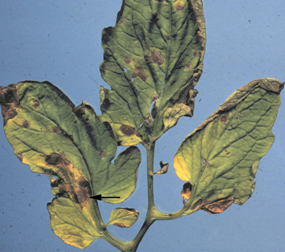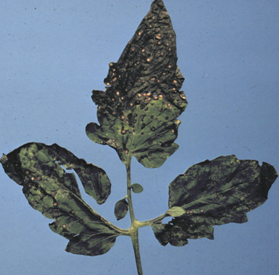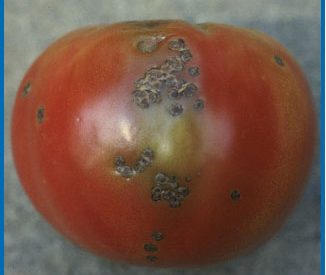
What is early blight?
Early blight is one of two common fungal diseases that can devastate tomatoes in both commercial settings and home gardens. Early blight can also be a serious disease on other popular vegetables including eggplants, peppers, and potatoes. The second common tomato blight, Septoria leaf spot.
What does early blight look like?
Symptoms of early blight first appear at the base of affected plants, where roughly circular, brown spots appear on leaves and stems. As these spots enlarge, concentric rings appear giving the areas a target-like appearance. Often spots have a yellow halo. Eventually multiple spots on a single leaf will merge, leading to extensive destruction of leaf tissue. Early blight can lead to total defoliation of lower leaves and even the death of an infected plant.
Where does early blight come from?
Early blight is caused by the fungus Alternaria solani, which survives on infected plants or in plant debris. Early blight symptoms typically begin as plant canopies start to close. Denser foliage leads to high humidity and longer periods of leaf wetness that favor the disease.
How do I save a plant with early blight?
Once symptoms of early blight appear, control is difficult. Thinning of whole plants or removal of selected branches from individual plants may slow the disease by increasing airflow and thus reducing humidity and the length of time that leaves remain wet. Fungicides labeled for use on vegetables and containing copper or chlorothalonil may also provide control of early blight if they are carefully applied very early in the course of the disease (before symptoms develop is best) and on a regular basis throughout the rest of the growing season. If you decide to use fungicides for disease control, be sure to read and follow all label instructions of the fungicide that you select to ensure that you use the product in the safest and most effective manner possible.
How do I avoid problems with early blight in the future?
Destroy infected plants and plant debris by burning (where allowed by local ordinance) or burying them. Move vegetables to different parts of your garden each year to avoid areas where the early blight fungus may be present. See Using Crop Rotation in the Home Vegetable Garden for details on this technique. Use early blight-resistant vegetable varieties whenever possible. Increase spacing between plants to increase airflow, and decrease humidity and foliage drying time. Mulch your garden with approximately one inch of a high quality mulch, but do not over-mulch as this can lead to wet soils that can contribute to increased humidity. Finally, where the disease has been a chronic problem, use of preventative applications of a copper or chlorothalonil-containing fungicide labeled for use on vegetables may be warranted.
For more information on early blight:
Contact the University of Wisconsin Plant Disease Diagnostics Clinic (PDDC) at (608) 262-2863 or pddc@wisc.edu.
Authors: Brian Hudelson, UW-Madison Plant Pathology
Last Revised: 02/29/2024
D-number: D0046
References to pesticide products in this publication are for your convenience and are not an endorsement or criticism of one product over similar products. You are responsible for using pesticides according to the manufacturer’s current label directions. Follow directions exactly to protect the environment and people from pesticide exposure. Failure to do so violates the law.
Thanks to Karen Delahaut, Lisa Johnson and Ann Joy for reviewing this document.
A complete inventory of UW Plant Disease Facts is available at the University of Wisconsin-Madison Plant Disease Diagnostics Clinic website: https://pddc.wisc.edu.
Send a Plant Sample for Analysis
Be cautious when self-diagnosing plant health issues. Very few diseases can accurately be diagnosed by eye.
Contact the UW Plant Disease Diagnostics Clinic (PDDC), and for a small fee, clinic staff can examine a plant, determine the cause of the disease/disorder, and provide advice on how to control or prevent the issue.
Download Article





 Blossom End Rot
Blossom End Rot Late Blight
Late Blight Septoria Leaf Spot
Septoria Leaf Spot Bacterial Spot of Tomato
Bacterial Spot of Tomato


